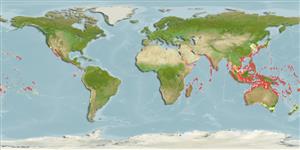Common names from other countries
Environment: milieu / climate zone / depth range / distribution range
Écologie
Récifal; profondeur 10 - 50 m (Ref. 93550). Tropical
Distribution
Pays | Zones FAO | Écosystèmes | Occurrences | Introductions
Indo-Pacific: from East Africa, including Madagascar and the Red Sea to eastern Polynesia; north to Japan and Hawaii, and south to New South Wales. Tropical and subtropical.
Length at first maturity / Taille / Poids / Âge
Maturity: Lm ? range ? - ? cm Max length : 3.5 cm SHL mâle / non sexé; (Ref. 348); common length : 2.5 cm SHL mâle / non sexé; (Ref. 348)
Found from immediate subtidal to 30 m in shelly sand; dead specimens to 45 m (Ref. 337). Feeds on detritus (Ref. 100890).
Life cycle and mating behavior
Maturité | Reproduction | Frai | Œufs | Fécondité | Larves
Members of the class Bivalvia are mostly gonochoric, some are protandric hermaphrodites. Life cycle: Embryos develop into free-swimming trocophore larvae, succeeded by the bivalve veliger, resembling a miniature clam.
Raines, B. and M. Huber. 2012. (Ref. 93550)
Statut dans la liste rouge de l'IUCN (Ref. 130435)
statut CITES (Ref. 108899)
Not Evaluated
Not Evaluated
Utilisations par l'homme
| FishSource |
Outils
Plus d'informations
Taille/ÂgeCroissanceLongueur-poidsLongueur-longueurMorphologieLarvesAbondance
Sources Internet
Estimates based on models
Preferred temperature
(Ref.
115969): 22.6 - 29.1, mean 28 (based on 946 cells).
Vulnérabilité
Low vulnerability (10 of 100).
Catégorie de prix
Unknown.
